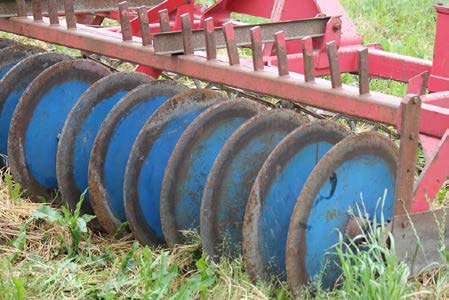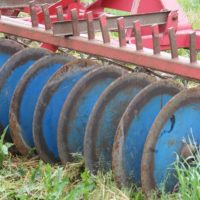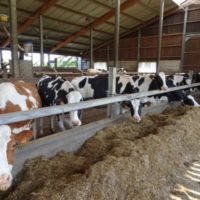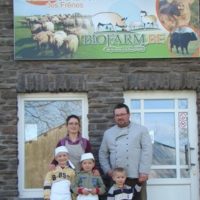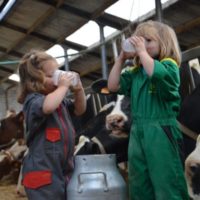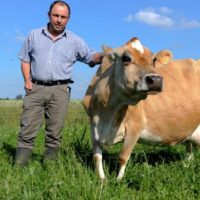Own constructed aerator for grasslands located on the peat-muck soils characterised by low porosity
Farm: “Mariusz Duda Farm”
Location: Wielkopolskie voivodeship, Poland
Case study
 Own constructed aerator for grasslands located on the peat-muck soils characterised by low porosity (.pdf)
Own constructed aerator for grasslands located on the peat-muck soils characterised by low porosity (.pdf)
Description
Background
Mr. Mariusz Duda runs his family farm in the west part of Wielkopolska voivodeship nearby the Opalenica town. This region has a long agricultural tradition of cereals and sugar beets cultivation, as well as animal production, especially dairy cows. Mr. Duda has taken his farm from his father and since that time he is increasing his production. At this moment he is cultivating an area of 120 ha and keeps 160 dairy cows with a high level of production, obtaining 10800 liters of milk per head during a year. This level of production can be obtained by the farmer thanks to his agricultural and economic know-how, own ambitions and constant improvement of the production and farm management system. The production on the farm is divided into two parts, the first is the crop production that is in 100 percent focused on the production of forage. The second part is the animal production based on the dairy herd that includes milk production and rearing young heifers. The animal nutrition is based on grass and maize silages. The maize is cultivated on the 50 ha of arable land in a conventional system and conserved as silage. The second part of the roughage feed production is based on the grasslands: 20 ha of temporary and 25 ha of permanent. The temporary grasslands consist of mix of intensive growing varieties of Medicago and Lolium westerwoldicum, which are sown on arable land. They are cut and the harvested yield is conserved as silage. The permanent grasslands in the farm are located on specific organic soils that have an inconvenient natural tendency to compactness and it is also increased due to the use of agricultural machinery. In the botanical composition of this grassland sward are dominated by Festuca arundinacea, Phleum pratense, Lolium perenne, Trifolium repens and Trifolium hybridum. Towards the process of soil compaction, a large part of those productive species falls out from the composition for other less productive species decreasing the amount of yield and its quality. This process cannot be even stopped or slowed towards regular renovation or other conventional cultivation treatments. The problem that has occurred in this case was how to provide optimal growth conditions for the sward to obtain a sufficient forage production.
Detailed description
The low grass production was a big problem especially when the farm started to extend the herd and increase their milk production. At that moment there wasn’t any possibility to purchase new land for forage production due to no sale offers in the close neighborhood. The farmer with his father started to analyze the problem how to increase the production level on currently managed specific grassland. Their curiosity and ambitions lead them to seek a solution to the problem through discussions and the use of own ideas. The conclusions were that they need to search for a proper way to restore meadows by adjusting the suitable seed mixtures to the specific habitat. At the same time the challenge was to find an optimal cultivation treatment that will allow to ensure optimal conditions for the growth and development of valuable meadow plants, especially humidity-air relations in organic meadow soil characterized by low porosity. The father of Mr. Mariusz Duda came up to an idea of constructing a plate aerator that will allow to loosen the compaction and insert air to the sod layer. The aerator is built on the construction of a cultivator and it has a 3 meters working area. The working elements are cutting plates adapted from another machine (potato harvester) and they are installed one next to another within 20 cm gaps. The plates are cutting the sod to a depth of 10-15 cm. The depth is regulated by adding some extra weight to the machine. The treatment with the aerator is applied after the harvest of each regrowth and its use is depended on the weather conditions, especially humidity of the soil.
Results
Aeration ensures the insertion of air to the sod layer, which has a positive effect on the growth and development of the valuable meadow plants and prevents the sward from the degradation processes due to soil compaction caused by machinery traffic. It provides also a better use of nutrients from applied fertilizers. As a result, it is possible to produce larger amounts of grass-based feeds for dairy cows, improve the botanical composition what results in a better quality of forage and increases the efficiency of fertilizer application. Also, the aeration maintains for a longer period of use stable botanical composition of the sward, especially after the renovation of the meadows.
Adoption criteria
The constructed aerator can be used in other farms that have problems with grasslands that are located on soils with a natural tendency to surface compacting. Its construction is very simple and in some cases it can be homemade by a farmer with some mechanic skills, with parts from other machines. The aeration treatment of grassland needs also from the farmer a very good knowledge about their habitat especially the soil type and its moisture content. In dry conditions the treatment will be no effective and if there will be too much of water in the soil the aeration can cause significant damage to the sward. In many cases the decision about the implementation of the treatment needs to be made immediately, and if it is going to be wrong applied it can lead to damage of the sward, unnecessary labor and cost loss. The aeration can give also good results on grasslands that are damaged towards the use of heavy agricultural machines especially on the technical roadways.
Future prospects
In his vision of dairy farm development Mr Duda is focusing on sustainable intensification of grassland management with introduction of many innovations, like presented aerator. Thanks to the innovation the farmer has increased his fodder production from the grasslands based on organic soil and secured his forage base for the extending herd. In his opinion, the obtained forage has very good quality and can be used for high-level milk production. The farmer indicates that the construction of the aerator needs some improvements. The organic type of meadow soils forces still some adjustment of the aerator in order to increase the efficiency of its work. The constructors have some ideas how to improve it and build another model. The new construction will give the possibility to work with higher speed and at the same time will not damage the sward. Those adjustments can improve the work of the aerator, decrease the time necessary to aerate all of the meadows what can lower the cost of a single treatment and give the possibility to save labor costs. The farmer sees some threat concerning the changing climate, especially after the last very dry year. The grassland management on organic peat-muck soil in such years with unstable weather conditions can bring new problems and difficulties to obtain a suitable amount of forage.
Additional information
| Farming system | conventional farming |
|---|---|
| Domains of innovation | machinery, tools |
| Main types of animal | dairy cattle |
| Country | Poland |
| Product type | Case study |
| Language | English |

